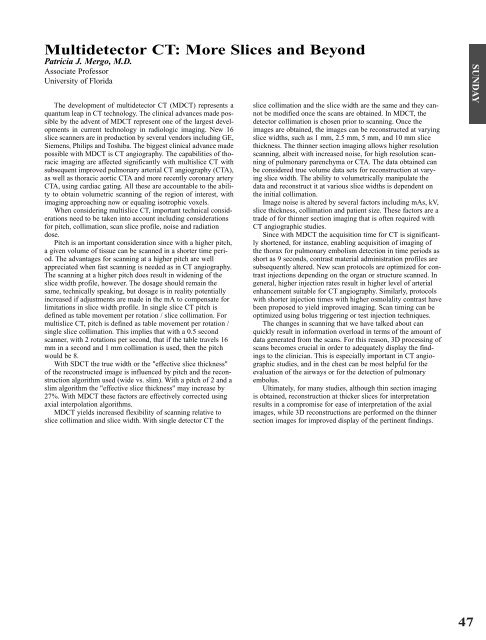Thoracic Imaging 2003 - Society of Thoracic Radiology
Thoracic Imaging 2003 - Society of Thoracic Radiology
Thoracic Imaging 2003 - Society of Thoracic Radiology
Create successful ePaper yourself
Turn your PDF publications into a flip-book with our unique Google optimized e-Paper software.
Multidetector CT: More Slices and Beyond<br />
Patricia J. Mergo, M.D.<br />
Associate Pr<strong>of</strong>essor<br />
University <strong>of</strong> Florida<br />
The development <strong>of</strong> multidetector CT (MDCT) represents a<br />
quantum leap in CT technology. The clinical advances made possible<br />
by the advent <strong>of</strong> MDCT represent one <strong>of</strong> the largest developments<br />
in current technology in radiologic imaging. New 16<br />
slice scanners are in production by several vendors including GE,<br />
Siemens, Philips and Toshiba. The biggest clinical advance made<br />
possible with MDCT is CT angiography. The capabilities <strong>of</strong> thoracic<br />
imaging are affected significantly with multislice CT with<br />
subsequent improved pulmonary arterial CT angiography (CTA),<br />
as well as thoracic aortic CTA and more recently coronary artery<br />
CTA, using cardiac gating. All these are accountable to the ability<br />
to obtain volumetric scanning <strong>of</strong> the region <strong>of</strong> interest, with<br />
imaging approaching now or equaling isotrophic voxels.<br />
When considering multislice CT, important technical considerations<br />
need to be taken into account including considerations<br />
for pitch, collimation, scan slice pr<strong>of</strong>ile, noise and radiation<br />
dose.<br />
Pitch is an important consideration since with a higher pitch,<br />
a given volume <strong>of</strong> tissue can be scanned in a shorter time period.<br />
The advantages for scanning at a higher pitch are well<br />
appreciated when fast scanning is needed as in CT angiography.<br />
The scanning at a higher pitch does result in widening <strong>of</strong> the<br />
slice width pr<strong>of</strong>ile, however. The dosage should remain the<br />
same, technically speaking, but dosage is in reality potentially<br />
increased if adjustments are made in the mA to compensate for<br />
limitations in slice width pr<strong>of</strong>ile. In single slice CT pitch is<br />
defined as table movement per rotation / slice collimation. For<br />
multislice CT, pitch is defined as table movement per rotation /<br />
single slice collimation. This implies that with a 0.5 second<br />
scanner, with 2 rotations per second, that if the table travels 16<br />
mm in a second and 1 mm collimation is used, then the pitch<br />
would be 8.<br />
With SDCT the true width or the "effective slice thickness"<br />
<strong>of</strong> the reconstructed image is influenced by pitch and the reconstruction<br />
algorithm used (wide vs. slim). With a pitch <strong>of</strong> 2 and a<br />
slim algorithm the "effective slice thickness" may increase by<br />
27%. With MDCT these factors are effectively corrected using<br />
axial interpolation algorithms.<br />
MDCT yields increased flexibility <strong>of</strong> scanning relative to<br />
slice collimation and slice width. With single detector CT the<br />
slice collimation and the slice width are the same and they cannot<br />
be modified once the scans are obtained. In MDCT, the<br />
detector collimation is chosen prior to scanning. Once the<br />
images are obtained, the images can be reconstructed at varying<br />
slice widths, such as 1 mm, 2.5 mm, 5 mm, and 10 mm slice<br />
thickness. The thinner section imaging allows higher resolution<br />
scanning, albeit with increased noise, for high resolution scanning<br />
<strong>of</strong> pulmonary parenchyma or CTA. The data obtained can<br />
be considered true volume data sets for reconstruction at varying<br />
slice width. The ability to volumetrically manipulate the<br />
data and reconstruct it at various slice widths is dependent on<br />
the initial collimation.<br />
Image noise is altered by several factors including mAs, kV,<br />
slice thickness, collimation and patient size. These factors are a<br />
trade <strong>of</strong> for thinner section imaging that is <strong>of</strong>ten required with<br />
CT angiographic studies.<br />
Since with MDCT the acquisition time for CT is significantly<br />
shortened, for instance, enabling acquisition <strong>of</strong> imaging <strong>of</strong><br />
the thorax for pulmonary embolism detection in time periods as<br />
short as 9 seconds, contrast material administration pr<strong>of</strong>iles are<br />
subsequently altered. New scan protocols are optimized for contrast<br />
injections depending on the organ or structure scanned. In<br />
general, higher injection rates result in higher level <strong>of</strong> arterial<br />
enhancement suitable for CT angiography. Similarly, protocols<br />
with shorter injection times with higher osmolality contrast have<br />
been proposed to yield improved imaging. Scan timing can be<br />
optimized using bolus triggering or test injection techniques.<br />
The changes in scanning that we have talked about can<br />
quickly result in information overload in terms <strong>of</strong> the amount <strong>of</strong><br />
data generated from the scans. For this reason, 3D processing <strong>of</strong><br />
scans becomes crucial in order to adequately display the findings<br />
to the clinician. This is especially important in CT angiographic<br />
studies, and in the chest can be most helpful for the<br />
evaluation <strong>of</strong> the airways or for the detection <strong>of</strong> pulmonary<br />
embolus.<br />
Ultimately, for many studies, although thin section imaging<br />
is obtained, reconstruction at thicker slices for interpretation<br />
results in a compromise for ease <strong>of</strong> interpretation <strong>of</strong> the axial<br />
images, while 3D reconstructions are performed on the thinner<br />
section images for improved display <strong>of</strong> the pertinent findings.<br />
47<br />
SUNDAY







